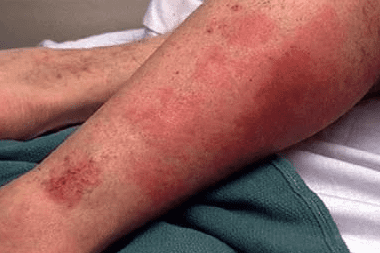Infectious diseases >>>> Erysipelas inflammation - what is it?
Erysipelas inflammation - what is it?

Erysipelas disease is of bacterial origin. The causative agent of the infection is hemolytic streptococcus A, which under normal conditions can constitute a conditionally pathogenic microflora, but under certain conditions of the body, when susceptibility to the toxins of this bacterium develops, it plays the role of a highly virulent infectious agent. Streptococcus A penetrates into the injured integument of the skin and mucous membranes and causes a persistent inflammatory process located in a limited focus. Streptococcus A has a variety of antigen modifications, which makes it less vulnerable to antibacterial effects.
Signs of erysipelas:
- first, there is a general reaction of the body to the presence of the toxin: fever, nausea, vomiting, headache, aching muscles, joints, apathy, convulsions and fainting are possible;
- later (after a few hours or a day) local symptoms of the disease begin to appear: itching, erythema, edema of the skin or mucous membranes;
- lymph nodes may be enlarged.
Depending on the nature of the rash, several forms of the disease are distinguished:
- erythematous - hemorrhagic, in which micro hemorrhages appear in the area of inflammation,
- erythematous - bullous, in which bubbles form in the area of inflammation,
- bulezno - hemorrhagic, in which there are petichiae and vesicles on the skin in the area of inflammation.
Erysipelas is multifaceted:
- it can be localized and recur in the same place,
- can increase the area of inflammation,
- can take a metastatic form,
- depending on the intensity of the intoxication effect of streptococcus, erysipelas can be mild, moderate and severe.

Inflammation of the erysipelas, as a rule, is serous in nature, but complicated erysipelas proceeds with purulent processes: abscesses or phlegmon develops. Tissue necrosis may develop in the area of purulent inflammation later. Treatment of erysipelas is carried out at home (outpatient). Inpatient treatment requires inpatient treatment in cases of frequent relapses, in certain age categories of patients (children, the elderly), with purulent complications of erysipelas.
Treatment of erysipelas is carried out etiotropically and symptomatically. Prescribe the latest generation of cephalosporins, penicillin, fluoroquinols, beta-lactams, lincomycin, macrolides. Symptomatic detoxification therapy is carried out, restoring water and electrolyte balance. The prognosis of recovery with erysipelas differs depending on the general state of health of the patient, his age, the characteristics of the course of the disease of erysipelas. In complicated cases, tissue healing occurs for a long time and ends with deep cicatricial changes. Frequent relapses complicate the healing process.

Read

Read



























